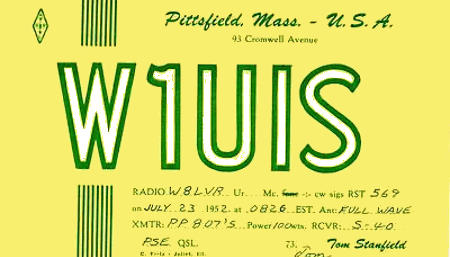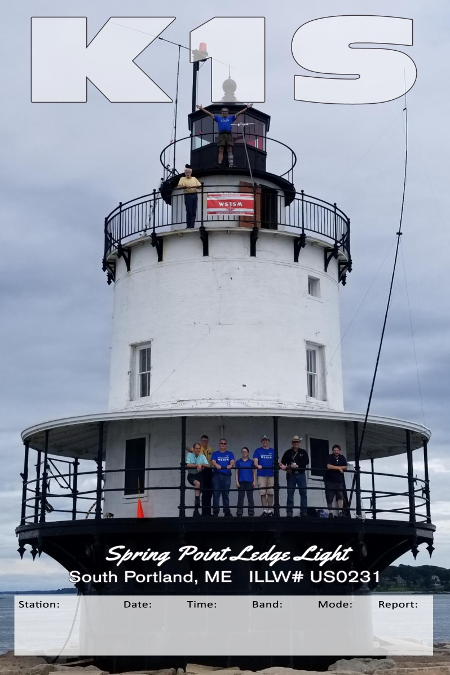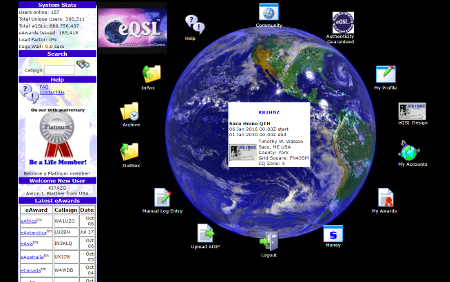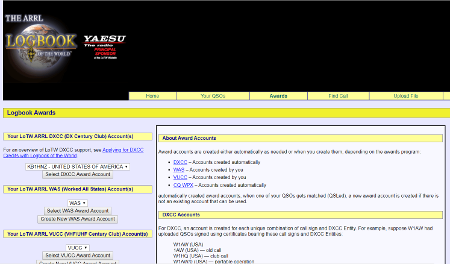|
QSLing
QSL
cards have been exchanged by
radio amateurs since the beginning of the hobby to confirm 2-way
contacts, but
the practice of QSLing is thought to predate amateur radio itself, as a
means
of verifying listener reports of some of the earliest experimental
broadcast
signals, especially when heard over long distances. QSL cards are often
said to
be the final courtesy of a contact, and indeed millions are exchanged
each
year.
While
QSL cards can provide proof for operating awards of a contact with a
particular entity or area, they are also interesting to collect as they
all have their own unique style, often reflecting a particular ham’s
interests or location, and sometimes come from distant countries or
remote islands.

Above: Traditional
QSL card, which
includes details such as Operator Call Sign, QTH, Call sign of station
worked, Signal report in RST, Date, Time, Antenna, Transmitter, Power
output, and Receiver info.
What is a QSL card?
The
term QSL comes from the radio
"Q" code meaning "I confirm reception", and the purpose of
a QSL card is to confirm a contact. The cards themselves are normally
post card
sized, many being very attractive. They often show photographs of the
ham radio
station, the operator, or the area in which he or she lives, and this
makes
them very interesting.
Originally,
ham radio operators
exchanged letters to confirm contacts, but eventually the idea of a
pre-printed
card arose. One reason is that they were cheaper to send through the
mail.
Another is that it saved time from having to write the same
information,
such as location and station details, over and over.
Today,
ham radio operators send
QSL cards for a variety of reasons. Often colorful, they are fun to
collect, and it’s nice to have a card that reminds one of a special
contact,
whether it was with a rare country or a memorable person.
QSLs
are also required when
applying for ham radio awards. One of the most famous awards is DXCC
(DX
Century Club), issued by the American Radio Relay League (ARRL), for
submitting
proof of making contacts with a hundred countries. Further endorsements
can be
added for making contacts with additional countries, or on multiple
bands or
modes.
 Above:
The QSL card for the K1S lighthouse activation from Spring Point Ledge
Light, in August 2018. Note that since this is for a portable operation
for International Lighthouse & Lightship Weekend (ILLW), it
includes the name of the lighthouse and ILLW number.
Above:
The QSL card for the K1S lighthouse activation from Spring Point Ledge
Light, in August 2018. Note that since this is for a portable operation
for International Lighthouse & Lightship Weekend (ILLW), it
includes the name of the lighthouse and ILLW number.
QSL Card Content
As
a bare minimum, a QSL card
should contain enough information to confirm a ham radio contact.
Normally the
card is pre-printed with the call sign of the originating ham radio
station
placed prominently on the front. In addition to this, ham radio QSL
cards should include
a number of other details, such as:
- Operator's name and address: This is
obviously very important as it
states where the station is located and who is operating the station.
Some additional
items associated with the location may be required for certain awards,
such as:
- Maidenhead Grid Square
locator:
This is important for people
operating on the VHF and UHF bands.
- Islands on the Air (IOTA Number): For
people located on an island,
this can
also be important for operators working towards their Islands on the
Air (IOTA)
award.
- Summits on the Air (SOTA Number):
For people operating from mountaintops, this can be important for
operators
working towards their SOTA awards.
- Others: If you’re
operating from
any number of special locations, such as lighthouses, World Wide Floral
and
Fauna sites, Parks on the Air (POTA), etc., be sure to include the
designators
for these locations, as they are important for operators seeking these
awards.
Some hams that do a lot of portable operating leave a space to write
this
information in.
- Callsign of station being
contacted: Necessary
to confirm any
2-way contact.
- Date: This is an
obvious requirement for
any QSL
card, but be sure to fill it in correctly, using the UTC date - not
your
local date.
- Time: The time
included on a QSL card is
normally
given in UTC - Universal Time Coordinated. By using
one global standard
there is no need for time zone conversions. Sometimes the letter 'z'
may be
used to denote UTC.
- Signal Report: The signal
report given is useful
because it
confirms the signal strength, readability and other factors related to
the
conditions at the time.
- Frequency / Band:
At the very
least, the band should be specified, but
preferably the frequency of the contact should be included.
- Mode of Operation: The mode of
operation is important.
Some DX
stations may run several stations at the same time, and therefore the
mode of
operation is important. It is also important when claiming awards as it
may be
necessary to detail the mode for a certain endorsement.
- Equipment Used:
It’s always
interesting to see what equipment
other hams are using.
- PSE / TNX
QSL:
It is helpful to have space to say whether a
card has been received, or whether one is wanted from the other
station.
Something like "PSE/TNX QSL" (please / thanks QSL) is often used.
Who uses QSL cards?
Many
individuals and
organizations send QSL cards, including:
- Ham Radio Operators: Many ham radio
operators, especially
those
using the HF bands, send them regularly. The practice is less common
for
contacts above 50 MHz, although for DX contacts many stations still
need to
collect QSL cards for awards.
- Short Wave Listeners:
Listeners often
send QSL cards as well. They
may send a card to a transmitting station to give a listener report in
the hope
of receiving a card back. The more common practice is to send a
Reception
Report, which includes many of the same details as you would put on a
QSL card,
but adds information such as propagation conditions, details of what
was heard,
and information about other stations heard in that area.
- Broadcast stations:
Occasionally, broadcast stations may send
QSL cards. To qualify for a QSL card, broadcast stations often require
that the
listener has listened to the station over a period of time (usually 30
minutes).
Besides the technical details, they also like to receive comments about
their
programming.
Collecting QSL Cards
Collecting
QSL cards has become
an interesting hobby in itself. Cards from distant corners of the earth
can be
attractive and displayed in the shack. Some hams and shortwave
listeners alike,
collect vintage QSLs, which turn up in places like antique shops and
estate
sales.

Electronic QSLs
With
the rise in the use of
electronic forms of sending and saving data, electronic QSLs or eQSLs
are now
widely used, providing lower cost of cards and delivery, increased
speed and
automation as well as greater functionality.
There
are two prominent
electronic QSL systems that are in use:
One
of the first electronic QSL
services was eQSL,
which enables the electronic exchange of QSL card images.
These electronic QSLs can then be printed on the recipient's local
printer.

eQSL
also offers their own award
program, but since 2009, CQ Amateur Radio magazine also began accepting
electronic QSLs from eQSL, for its award programs, and the Deutscher
Amateur
Radio Club (DARC) began accepting eQSLs for their award programs around
the
same time. Many logging programs also have the ability to directly
interface
with the eQSL database to transmit contact details in real-time.
Click
here to
visit eQSL’s website.
The
ARRL's Logbook of the
World (LoTW) program was introduced in 2004. This
electronic QSL method enables
confirmations to be submitted electronically. The electronic QSL
confirmations
are in the form of database records which are electronically signed
with the
private key of the sender.

These
confirmations are accepted
for ARRL award programs, including DXCC and Worked All States (WAS),
and this
makes applying for these awards very easy, once the system has been set
up. It
enables DXCC or WAS status to be automatically updated as new logs come
in.
The
downside for LoTW is that the
system simply matches database records and does not have the ability to
create
QSL card images that can be printed out for collecting.
The ARRL Logbook of The
World
LOTW can be reached here.
What is a QSL Bureau?
A
QSL bureau or buro, is a
well-established system for sending amateur radio QSL cards in bulk via
the
post.
The
traditional way of sending
QSL cards is through the mail, but sending cards directly is costly as
many of
them need to be sent overseas.
In
order to overcome this, the
QSL bureau concept enables cards to be sent in bulk. Although it takes
more
time, the QSL bureau provides a very much more cost effective way of
sending
cards.
In
many countries it is possible
for members to send and receive cards via the bureau run by their
national
society - the national society may also allow non-members to collect
cards but
not send them.
How to use a QSL bureau
Where
a QSL bureau exists and
operates reliably, it is usually very simple to use. There are incoming
and
outgoing routes, each of which operates in a slightly different manner.
Although
each QSL bureau will
have slightly different rules, they all operate in basically the same
way.
Outgoing
QSL cards: When
sending cards out through the QSL
bureau, they can be assembled at home. It normally helps to sort them
into
countries, and where applicable, into call areas. All the cards should
be
clearly marked with the callsign of the recipient. If the back of the
card is
clear - mark it here as well, and if there is a QSL manager mark this
clearly
as well. Collect these in a large envelope and send it to the required
address
of your national society for outgoing QSL cards. Hams in the United
States may
use the ARRL Outgoing QSL Service. Click
here for more info.
Incoming
QSL cards: To
claim any incoming QSL cards, it is
typically necessary to either send pre-paid envelopes or postage to the
bureau.
Your callsign should be printed on the envelope, typically in the upper
left-hand
corner. These envelopes should be sent to the required address for your
particular bureau. Hams in Maine will use the W1 QSL bureau, which is
sponsored
by the Yankee Clipper Contest Club: http://www.w1qsl.org/
QSL
Managers
Many
DXpeditions, contest
operators, and stations located in countries with unreliable postal
service, rely
on QSL managers to send their cards for them. Most of these operators
will post
details about the QSL Manager on their QRZ page. They will also specify
whether
QSL cards should be sent either directly to the QSL manager, or via the
bureau.
- Direct: When sending
cards to a QSL manager,
it is
normally expected that the return postage will be sent along. This is
common
courtesy for any direct QSL request, but it is usually required by
managers.
Often QSL managers will request International Reply Coupons (or IRCs)
to pay
for airmail and other expenses, but IRCs are difficult to obtain in the
U.S. An
accepted alternative is to include two or more US Dollar bills in with
the
card.
- Via the bureau:
When sending cards to a QSL manager via the
bureau, the QSL manager's call should be clearly indicated on the card,
saying
station1 via station2. In this way, the card can be routed to the the
QSL
manager instead of the actual station that was contacted.
Since
you're here, you may also be interested in: Writing
a Reception Report
Click
here to download a logo that you may use on your QSL card, or
QRZ page.
|